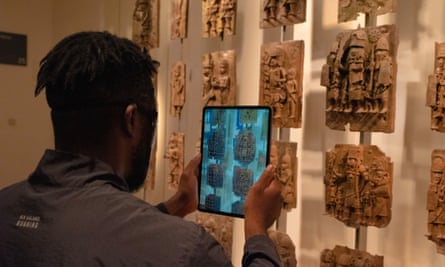Art
'Can you steal back something that's already stolen?': how radical art duo Looty repatriated the Rosetta Stone – The Guardian
In March last year, two men in tracksuits, wearing hockey masks and carrying matching laundry bags, headed for the British Museum. Just outside, patrolling police asked the two strange-looking men where they were going. “We’re going to the British Museum to loot back stolen goods,” one of them said. “Well, we’ll see you in there then!” the policewoman answered.
But no arrests were made, as nothing incriminating happened. What did take place was a “digital heist” of one of the most famous objects in the British Museum, an artefact that is, according to Egyptologist Monica Hanna, “a symbol of western cultural power” and “of British imperialism”: the Rosetta Stone.
The heist involved the pair, plus Hanna, whom they had invited along, going to the vitrine where the stela is displayed and making detailed 3D scans of it on an iPad. This effectively provided the “looters” with a digital copy of the artefact from 196BC totally legally. But their goal wasn’t merely to digitise the Rosetta Stone, but to return it to its place of origin, Rashid (or Rosetta), Egypt, using location-based augmented reality technology (or Geo AR), for local people to view the object from their smartphones.
The two men behind the masks were London-based Chidi Nwaubani and Ahmed Abokor, a product designer and a creative consultant, respectively. Together they make up Looty, a radical “artivist” collective and tech company founded in 2021 that aims to “loot back” stolen cultural artefacts from museums. First by 3D scanning them, then by sharing them as revamped digital artworks through non-fungible tokens (NFTs).
As NFTs provide public proof of the ownership of digital files, Looty’s method of “stealing” and redistributing artworks aims to challenge the lack of transparency and the fading relevance often associated with institutions founded in the colonial era. After the British Museum’s scandal last August, in which about 2,000 artefacts were reportedly stolen due to poor record-keeping, revealing that about half of its collection of around 8m objects was never fully catalogued, the 18th-century-founded museum is again facing a public reckoning.
“They don’t really care about the artefacts, they care more about the fact that they have them,” Abokor says. “It’s all about power again.”
From organising one of the main interactive exhibitions at last year’s Venice Architecture Biennale to mounting an installation at NFT Paris in February this year, Looty is taking the art and tech worlds by storm. In November, they were selected in the Special Projects category at the 1-54 Contemporary African Art Fair. Continuing their Rosetta stone heist project, Abokor had made a replica of it with fabric and rope wrapped round it. Visitors could scan the stone using a QR code included in the artwork’s description, triggering an animation on their phones and an augmented reality (AR) experience that showcased the Rosetta Stone in its original size and glory.
Nwaubani and Abokor’s partnership goes back about 20 years when they met at university in London, bonding over their creative spirits and shared African heritage. Nwaubani was raised mostly around Guildford and developed an early interest in tech by “coding computer games on floppy disks”. But he experienced intense racism at school, leading his father, a university professor originally from Nigeria, to change his school.
“You can’t be a black person living in Europe and not have some level of political affiliation. You’re already politicised by what happens to you growing up,” Nwaubani says.

Born in Somalia, Abokor was only 12 months old when his family moved to Sweden and ended up living in a refugee camp. “Coming from war, it’s ingrained in us to understand politics and know what’s happening around us,” he says.
The two recall that when they were young, their parents would offer “alternative” history lessons of European museums, explaining where objects “really” come from. This helped develop their curiosity about Africa’s rich and often misrepresented history, and taught them that power and politics are ingrained in art.
It was around Christmas 2020 when Nwaubani first got the idea for Looty; the collective’s name refers to a Pekingese dog owned by Queen Victoria that British soldiers looted from China’s Summer Palace in 1860. He read a report that revealed that 90 to 95% of Africa’s cultural heritage is held by major museums outside Africa. Inspired by the boom in NFTs, Nwaubani thought of a project “around the idea of: ‘Can you steal back something that’s already stolen?’”
The technology that would help bring this concept of digital looting and restitution to life is Lidar, a form of 3D scanning that stands for “light detection and ranging” and uses eye-safe laser beams to “see” the world in 3D. Lidar allows Looty to digitally record artefacts and render them in 3D. They then make them available on the blockchain as NFTs and “counter reimaginations of the originals” according to Nwaubani – bypassing bureaucratic processes that prevent people from developing countries from seeing these artworks face to face.
Before the Rosetta, their first project was with the Benin bronzes, another heavily disputed colonial artefact scattered across western museums. Looty released a limited collection of 25 NFTs of the bronzes based on a looted Oba (king) head from the British Museum. Each sale contributes 20% into the Looty Fund, which gives out grants to young African artists, especially from Nigeria.
What they discovered was that the museum world is still adapting to the era of mass digitisation. On its website, the British Museum says it allows 3D photographs and printing of objects for non-commercial use, and asks visitors “to be mindful and respectful” of objects that are “culturally sensitive”.
“When the British stormed the Benin kingdom [in 1897] there were no laws against that, or they would create a law around it to make it legal,” says Nwaubani. “Now we’re in an era where there are no laws against what we do.”
“And tech moves faster than law as well,” Abokor adds.
It is a dilemma facing cultural institutions in the digital era: while many artists wish to use technology to make culture more accessible and, in the case of Looty, less western-centric, museums are trying to adapt without losing their ability to draw audiences.
For Berlin-based artist Oliver Laric, who has digitised the collections of a dozen museums across Europe, museums must realise that “there is an urgent need for alternatives” to centralised cultural heritage institutions. “There are many fears based on false legal assumptions, but also fears of some kind of loss as a result of accessibility”, he says. “When talking to museums I often brought up a very simplistic example: no amount of replicas or merchandise will keep people from wanting to see the Mona Lisa in person, rather the opposite”.
Although the restitution work in Europe may seem remote from the preoccupations of people on the ground in formerly colonised nations, heritage experts say that these issues are significant for many in the global south.
“People are already thinking of how the repatriation will fit into the local economy, and how restitution and repatriation can create job opportunities,” Monica Hanna says about the city of Rashid, Egypt, where the Rosetta Stone can now be viewed in an augmented reality installation using a QR code through apps such as Snapchat.
With a calm yet trailblazing energy, Nwaubani invokes the vision of Steve Jobs with the Pan-Africanism of Chinua Achebe. Looty’s motto is “the future awaits your return” – to evoke “a constant dialogue between the past and the future”, and establish Looty as a “counter-imagination” of the museum.
These days, we’re less likely to find the pair “looting” the British Museum. Instead they’re busy preparing their next interactive exhibition somewhere between Europe and Africa. Although they feel they’ve achieved a lot these past three years, they say there’s still a long road ahead. Like technology, culture is always changing, and the two “looters” are not only embracing innovations but also dreaming of the ones still to come.
Art
Duct-taped banana artwork auctioned for $6.2m in New York – BBC.com
[unable to retrieve full-text content]
- Duct-taped banana artwork auctioned for $6.2m in New York BBC.com
- A duct-taped banana sells for $6.2 million at an art auction NPR
- Is this banana duct-taped to a wall really worth $6.2 million US? Somebody thought so CBC.ca
Art
40 Random Bits of Trivia About Artists and the Artsy Art That They Articulate – Cracked.com
[unable to retrieve full-text content]
40 Random Bits of Trivia About Artists and the Artsy Art That They Articulate Cracked.com

Source link
Art
John Little, whose paintings showed the raw side of Montreal, dies at 96 – CBC.ca
[unable to retrieve full-text content]
John Little, whose paintings showed the raw side of Montreal, dies at 96 CBC.ca

Source link
-

 News17 hours ago
News17 hours agoEstate sale Emily Carr painting bought for US$50 nets C$290,000 at Toronto auction
-

 News17 hours ago
News17 hours agoClass action lawsuit on AI-related discrimination reaches final settlement
-

 News17 hours ago
News17 hours agoCanada’s Hadwin enters RSM Classic to try new swing before end of PGA Tour season
-

 News18 hours ago
News18 hours agoAll premiers aligned on push for Canada to have bilateral trade deal with U.S.: Ford
-

 News17 hours ago
News17 hours agoTrump nominates former congressman Pete Hoekstra as ambassador to Canada
-

 News17 hours ago
News17 hours agoEx-student pleads guilty to fatally shooting 3 University of Virginia football players in 2022
-

 News17 hours ago
News17 hours agoFormer PM Stephen Harper appointed to oversee Alberta’s $160B AIMCo fund manager
-

 News17 hours ago
News17 hours agoComcast to spin off cable networks that were once the entertainment giant’s star performers





















